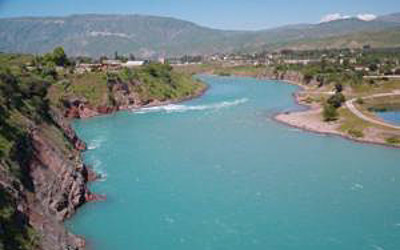AKIPRESS.COM -  Tajikistan faces an energy crisis every winter. The mountainous country has devised a potential solution – build a hydroelectric dam across its Vakhsh River. And not just any dam, but potentially one of the world’s tallest, at a slated 335 meters, or slightly taller than the Eiffel Tower.
Tajikistan faces an energy crisis every winter. The mountainous country has devised a potential solution – build a hydroelectric dam across its Vakhsh River. And not just any dam, but potentially one of the world’s tallest, at a slated 335 meters, or slightly taller than the Eiffel Tower.
Tajikistan’s Government plans to relocate 42,000 people whose homes are on land that will be flooded by the Rogun Dam project. But, some of the 1,500 families who have already been resettled are struggling to build new homes, no longer have enough land to farm or regular access to clean water, and face other serious problems, Human Rights Watch reports.
The Government has suspended resettlement while the World Bank conducts feasibility studies on the dam. Human Rights Watch talks about the necessity to convince Tajikistan, and the World Bank, to make changes to the relocation plan.
Tajikistan depends on hydroelectric power for much of its energy. People there have electricity all the time during the summer, when melting snowcaps keep the rivers higher. But there are perpetual energy shortages during the winter, leaving people in many parts of Tajikistan with electricity for only a few hours a day in rural areas. The rest of the time, people use wood and coal stoves for heating and cooking. But this can be expensive, inefficient, and bad for their health. Many people can struggle to keep their homes warm.
The dam may be problematic when it comes to displacing people, but it sounds like it could significantly ease a serious energy problem.
The Government believes the dam could potentially solve Tajikistan’s energy crisis and provide regular power to the people who need it. Tajikistan is Central Asia’s poorest country, with almost half its GDP coming from remittances of people who migrate to Russia for work. With the dam, the Tajik Government could boost its economy by selling surplus energy. But there’s no reason this can’t happen while the Government carries out a resettlement program that respects the rights of the 42,000 people being moved to make way for the dam. The Government needs to provide adequate compensation and enable people to maintain their standard of living throughout the relocation process.
The first 1,500 families resettled were from small mountain villages. Nearly all of them relied on farming and livestock for sustenance and in some cases for income. People grow wheat, alfalfa, potatoes, onions, and lots of other vegetables. They have orchards with apple, pear, walnut, and mulberry trees. They raise animals, and some keep bees. They didn’t have indoor plumbing, but they used hoses or pipes to bring fresh water from mountain springs into their yards.
These families have been resettled into much more arid parts of the country, in some cases almost 200 kilometers from their original homes. The Government hasn’t made enough farmland available for families to either raise livestock or grow a garden to feed themselves.
Families can apply to the Government for additional farmland, but the Government hasn’t given most people information on the land’s availability or on how to apply for it.
Different communities face different issues. Some aren’t getting enough water, as it’s supplied by electricity in their new homes, as opposed to a mountain stream, and there’s electricity only for a few hours a day for much of the year. Schools haven’t been built near all communities. Some kids have to walk up to two hours to reach their school, and understandably some parents are reluctant to send them during the cold winter months or bad weather.
The Government has addressed some problems. They have built a school for one community, and has taken steps to build some settlements closer to the original communities, so people can maintain similar livelihoods with farming. But more needs to be done.
According to the feasibility studies, the dam is estimated to cost between $3 and $5 billion, and the Government is seeking funds from outside donors. An adequate portion of this very large sum should be dedicated to resettlement.
Two decades ago, the World Bank stopped funding these types of large-scale, potentially transformative projects because of the human rights abuses and other issues they ran up against. While the World Bank hasn’t committed to funding the dam, it is commissioning assessments to assist the Tajik Government.
The World Bank is doing two feasibility studies on the dam, one of which concerns resettlement. The studies were just released last week for public comment. They make clear that resettlement is going to be a major impact of the dam and that restoration of people’s livelihoods needs to be a priority. On the other hand, there are some big gaps. While the studies consider international environmental laws, they don’t cite any international human rights standards.
Resettlement is suspended as the World Bank finalizes these studies. Tajikistan has agreed to abide by the World Bank’s recommendations. If human rights activists can highlight what needs to be changed to both the World Bank and Tajikistan, it could prevent the next 5,500 families to be resettled from experiencing similar rights abuses.
